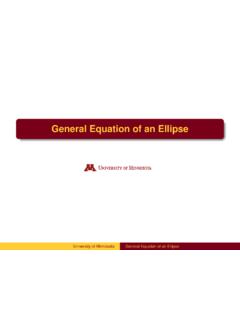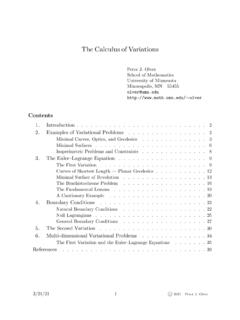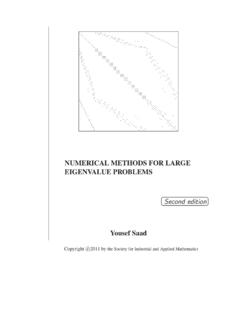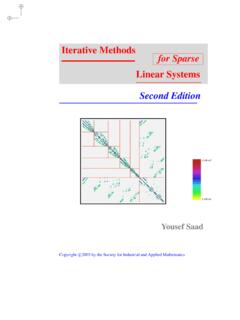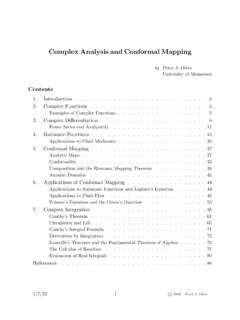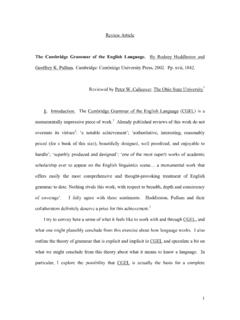Transcription of Nonlinear Systems - University of Minnesota
1 Nonlinear Systemsby peter J. OlverUniversity of Minnesota1. is ubiquitous in physical phenomena. Fluid and plasma mechanics, gasdynamics, elasticity, relativity, chemical reactions, combustion, ecology, biomechanics, andmany, many other phenomena are all governed by inherently Nonlinear equations. (The onenotable exception is quantum mechanics, which is a fundamentally linear theory, althoughrecent attempts at grand unification of all fundamental physical theories, such as stringtheory and conformal field theory, [8], are Nonlinear .) For this reason, an ever increasingproportion of modern mathematical research is devoted to the analysis of Nonlinear systemsand Nonlinear , then, does one devote so much time studying linear mathematics?
2 The facileanswer is that Nonlinear Systems are vastly more difficult to analyze. In the nonlinearregime, many of the most basic questions remain unanswered:existence and uniqueness ofsolutions are not guaranteed; explicit formulae are difficult to come by; linear superpositionis no longer available; numerical approximations are not always sufficiently accurate; etc.,etc. A more intelligent answer is that a thorough understanding of linear phenomenaand linear mathematics is an essential prerequisite for progress in the Nonlinear , one must first develop the proper linear foundations in sufficient depth beforewe can realistically confront the untamed Nonlinear wilderness.
3 Moreover, many importantphysical Systems are weakly Nonlinear , in the sense that,while Nonlinear effects doplay an essential role, the linear terms tend to dominate thephysics, and so, to a firstapproximation, the system is essentially linear. As a result, such Nonlinear phenomena arebest understood as some form of perturbation of their linearapproximations. The trulynonlinear regime is, even today, only sporadically modeledand even less well advent of powerful computers has fomented a veritable revolution in our under-standing of Nonlinear mathematics. Indeed, many of the mostimportant modern analyticaltechniques drew their inspiration from early computer-aided investigations of Nonlinear sys-tems.
4 However, despite dramatic advances in both hardware capabilities and sophisticatedmathematical algorithms, many Nonlinear Systems for instance, fully general Einsteiniangravitation, or the Navier Stokes equations of fluid mechanics at high Reynolds numbers still remain beyond the capabilities of today s goal of these lecture notes is to provide a brief overviewof some of the mostimportant ideas, mathematical techniques, and new physical phenomena in the nonlinearrealm. We start with iteration of Nonlinear functions, alsoknown as discrete dynamicalsystems. Building on our experience with iterative linear Systems , as developed in Chap-ter 10 of [15], we will discover that functional iteration, when it converges, provides a6/28/211c 2021 peter J.
5 Olverpowerful mechanism for solving equations and for optimization. On the other hand, evenvery simple non-convergent Nonlinear iterative Systems may admit remarkably complex,chaotic behavior. The third section is devoted to basic solution techniques for nonlinearequations and Nonlinear Systems , and includes bisection, general iteration, and the verypowerful Newton Method. The fourth section is devoted to finite-dimensional optimiza-tion principles, , the minimization or maximization ofnonlinear functions, and includingsystems with constraints leading to the method of Lagrange multipliers. Numerical opti-mization procedures rely on iterative procedures, and we concentrate on those associatedwith gradient Iteration of , meaning repeated application of a function, canbe viewed as adiscretedynamical systemin which the continuous time variable has been quantized to assumeinteger values.
6 Even iterating a very simple quadratic scalar function can lead to an amaz-ing variety of dynamical phenomena, including multiply-periodic solutions and genuinechaos. Nonlinear iterative Systems arise not just in mathematics, but also underlie thegrowth and decay of biological populations, predator-preyinteractions, spread of commu-nicable diseases such asAids, and host of other natural phenomena. Moreover, manynumerical solution methods for Systems of algebraic equations, ordinary differentialequations, partial differential equations, and so on rely on iteration, and so the the-ory underlies the analysis of convergence and efficiency of such numerical general, an iterative system has the formu(k+1)=g(u(k)),( )whereg:Rn Rnis a real vector-valued function.
7 (One can similarly treat iteration ofcomplex-valued functionsg:Cn Cn, but, for simplicity, we only deal with real systemshere.) A solution is a discrete collection of points u(k) Rn, in which the indexk=0,1,2,3, ..takes on non-negative integer values. Chapter 10 of [15] dealt with the casewheng(u) =Auis a linear function, necessarily given by multiplication by ann nmatrixA. In this chapter, we enlarge our scope to the Nonlinear we specify the initial iterate,u(0)=c,( )then the resulting solution to the discrete dynamical system ( ) is easily computed:u(1)=g(u(0)) =g(c),u(2)=g(u(1)) =g(g(c)),u(3)=g(u(2)) =g(g(g(c))), ..and so on. Thus, unlike continuous dynamical Systems , the existence and uniqueness ofsolutions is not an issue.
8 As long as each successive iterateu(k)lies in the domain of The superscripts onu(k)refer to the iteration number, and donotdenote 2021 peter J. Olverdefinition ofgone merely repeats the process to produce the solution,u(k)=ktimesz}|{g g(c),k= 0,1,2, .. ,( )which is obtained by composing the functiongwith itself a total ofktimes. In otherwords, the solution to a discrete dynamical system corresponds to repeatedly pushing thegkey on your calculator. For example, entering 0 and then repeatedly hitting thecoskeycorresponds to solving the iterative systemu(k+1)= cosu(k),u(0)= 0.( )The first 10 iterates are displayed in the following table:k0 123456789u(k)0 simplicity, we shall always assume that the vector-valued functiong:Rn Rnisdefined on all ofRn; otherwise, we must always be careful that the successive iteratesu(k)never leave its domain of definition, thereby causing the iteration to break down.
9 To avoidtechnical complications, we will also assume thatgis at least continuous; later results relyon additional smoothness requirements, , continuity of its first and second order the solution to a discrete dynamical system is essentially trivial, understandingits behavior is definitely not. Sometimes the solution converges to a particular value the key requirement for numerical solution methods. Sometimes it goes off to , or, moreprecisely, the norms of the iterates are unbounded:ku(k)k ask . Sometimesthe solution repeats itself after a while. And sometimes theiterates behave in a seeminglyrandom, chaotic manner all depending on the functiongand, at times, the initialconditionc.
10 Although all of these cases may arise in real-world applications, we shallmostly concentrate upon understanding pointorequilibriumof a discrete dynamical system ( ) isa vectoru Rnsuch thatg(u ) =u .( )We easily see that every fixed point provides a constant solution to the discrete dy-namical system, namelyu(k)=u for allk. Moreover, it is not hard to prove that anyconvergent solution necessarily converges to a fixed a solution to a discrete dynamical system converges,limk u(k)=u ,then the limitu is a fixed point. In view of the equivalence of norms on finite-dimensional vector spaces, cf. [15], any normwill do 2021 peter J.
